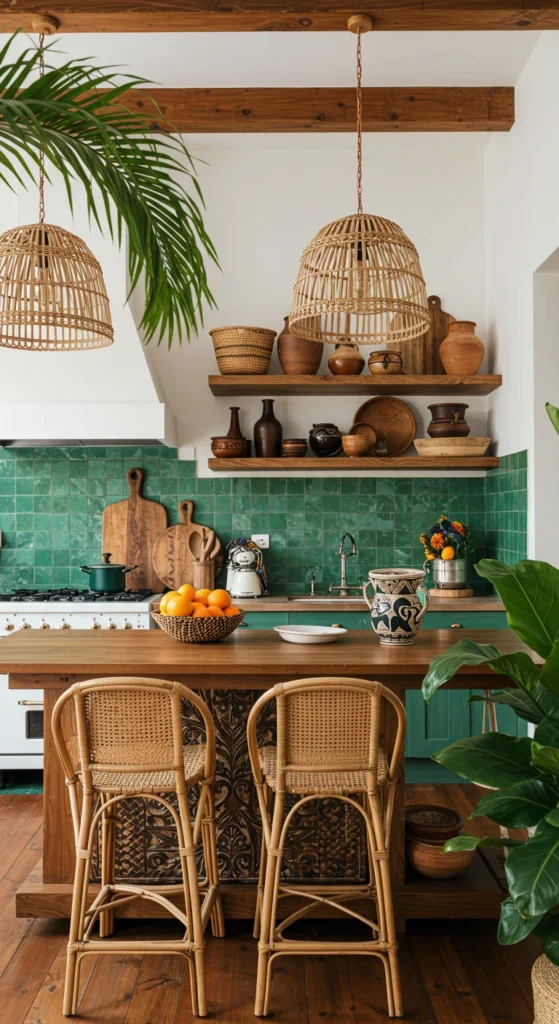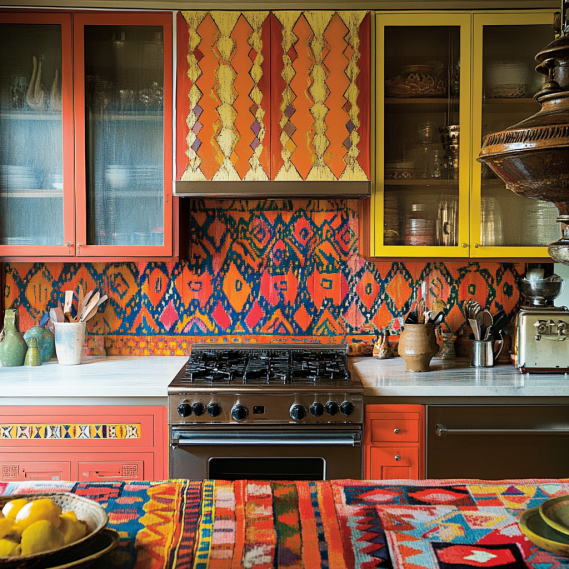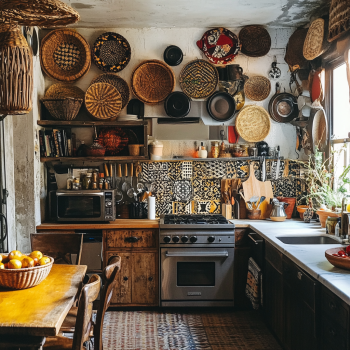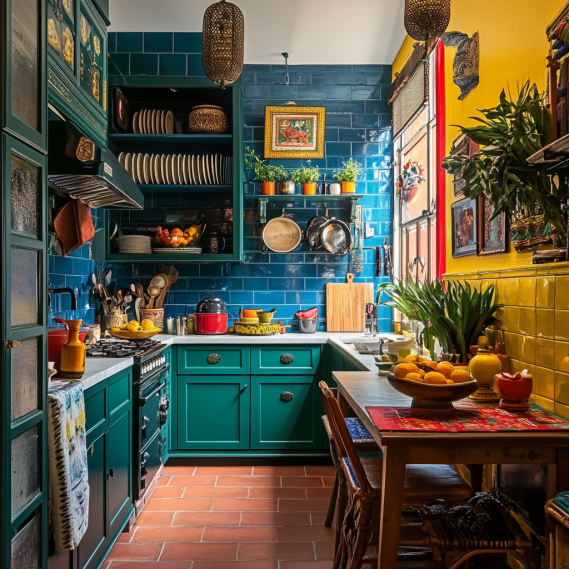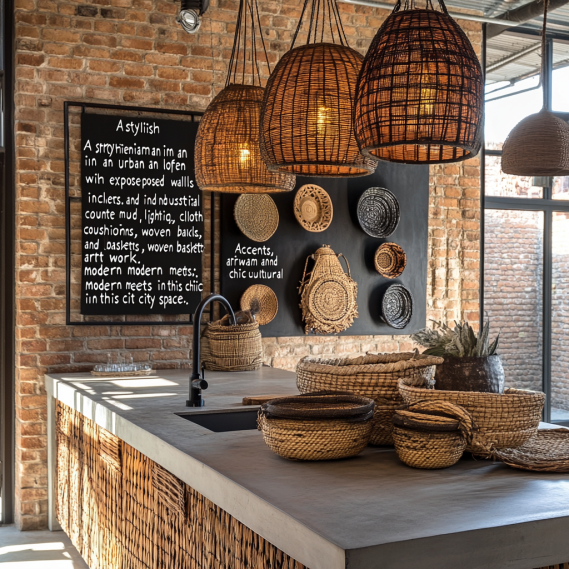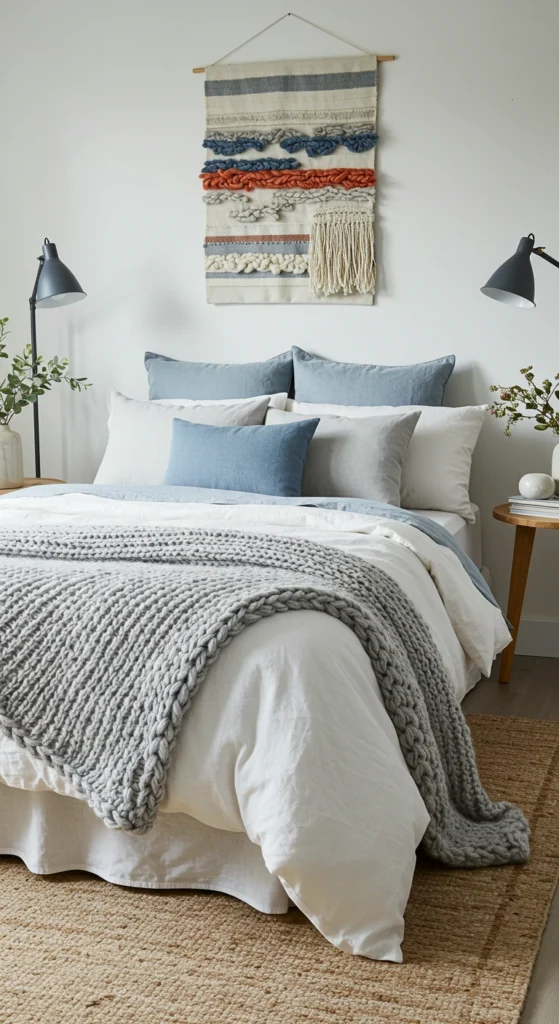In the ever-evolving world of interior design, cultural fusion continues to produce some of the most innovative and soulful aesthetics. Among these emerging styles, Afrohemian kitchen design stands out as a particularly inspired blend—marrying the rich cultural heritage of African artistry with the carefree, eclectic spirit of Bohemian style. This unique design approach transforms ordinary kitchens into extraordinary spaces that tell stories, celebrate diversity, and inspire creativity.
The Birth of Afrohemian Style
The term “Afrohemian” perfectly captures the essence of this design movement—a harmonious marriage between African cultural elements and Bohemian free-spiritedness. Unlike strictly traditional African or purely Bohemian spaces, Afrohemian kitchens draw strength from both worlds: the soulful rhythms and meaningful symbolism of African design traditions paired with the laid-back, unconventional approach of Bohemian aesthetics.
This fusion creates spaces that feel simultaneously grounded in cultural heritage and liberated from rigid design rules. The result? Kitchens that serve not just as functional cooking spaces but as vibrant expressions of personal identity and cultural appreciation.
Exploring the Afrohemian Kitchen Landscape
1. Tropical Afrohemian Kitchen
Step into a Tropical Afrohemian kitchen and you’re immediately enveloped in a sensory celebration. These spaces dance with vibrant hues inspired by tropical landscapes—lush jungle greens, sunset oranges, and ocean blues—while incorporating authentic African textures through handwoven baskets, carved wooden serving boards, and handcrafted pottery. The tropical influence brings lightness and airiness, while African elements add depth and cultural significance.
Natural materials reign supreme here, with rattan pendant lights hovering above wooden countertops, while potted tropical plants bring life to corners and windowsills. The overall effect creates a kitchen that feels both exotic and welcoming.
2.Luxe Afrohemian Cooking Space
For those who desire a more sophisticated interpretation, the Luxe Afrohemian kitchen elevates the concept through opulent material choices and refined detailing. Here, you might find veined marble countertops alongside custom cabinetry featuring subtle African-inspired motifs. Brushed brass fixtures catch the light, while carefully selected artifacts—perhaps a collection of hand-carved ceremonial spoons or intricately patterned textiles—serve as artistic focal points.
The luxury doesn’t come from ostentation but rather from the thoughtful curation of high-quality materials and authentic cultural pieces that tell stories of craftsmanship and heritage.
3.Minimalist Afrohemian Kitchen
Proving that cultural fusion doesn’t have to be visually overwhelming, the Minimalist Afrohemian approach embraces clean lines and uncluttered spaces while incorporating African elements with intentional restraint. These kitchens often feature neutral color palettes of whites, creams, and warm woods, punctuated by carefully chosen African accents—perhaps a single dramatic textile art piece, a sculptural wooden stool at a breakfast bar, or a collection of hand-thrown earth-toned pottery displayed in an open shelf.
The beauty lies in this balance: modern minimalism providing a serene canvas for meaningful cultural elements that stand out all the more for their thoughtful placement.
4.Bold Afrohemian Patterns
Some homeowners embrace the visual drama inherent in traditional African patterns, making them central to their kitchen design. These spaces showcase striking geometric motifs and tribal patterns across various surfaces—from statement backsplashes featuring Moroccan zellige tiles to cabinet fronts embellished with kente cloth-inspired designs.
Pattern mixing becomes an art form in itself, with traditional African prints complemented by bohemian ikat or batik textiles. What prevents these spaces from feeling overwhelming is the thoughtful color coordination and the balance of patterned elements with solid surfaces that allow the eye moments of rest.
5.Eclectic Afrohemian Culinary Retreat
Perhaps the most true to bohemian philosophy, these kitchens embrace a collected-over-time aesthetic that blends various textures, colors, and design elements into spaces that feel deeply personal. Here, contemporary appliances might sit alongside vintage finds, while handcrafted African baskets hang from ceiling beams and colorful textiles warm wooden surfaces.
These kitchens tell stories of travels, cultural appreciation, and personal history—spaces where nothing matches perfectly, yet everything harmonizes in a celebration of individuality and cultural cross-pollination.
6.Modern Afrohemian Elegance
For those who appreciate contemporary design but desire cultural warmth, Modern Afrohemian kitchens offer a sophisticated solution. These spaces feature clean architectural lines, sleek cabinetry, and modern fixtures as their foundation, then layer in carefully curated African influences—perhaps a set of hand-carved wooden bar stools, a gallery wall of masks or artifacts displayed with museum-like precision, or statement lighting inspired by traditional African forms.
The result balances cool modernism with cultural richness, creating spaces that feel both current and timeless.
7.Earthy Afrohemian Harmony
Drawing directly from the natural materials so central to both African crafts and bohemian aesthetics, these kitchens celebrate the beauty of earth-derived elements. Clay tiles, wooden countertops, stone surfaces, and natural fibers dominate, while the color palette mirrors landscapes—terracottas, ochres, forest greens, and desert sands.
These spaces feel grounded and authentic, connecting cooking activities with ancient traditions of working with materials from the earth. Handmade ceramics, wooden utensils, and stone mortars aren’t just decorative here—they’re functional connections to cooking traditions that span continents and centuries.
8.Vibrant Afrohemian Color Splash
Not for the color-shy, these joyful kitchens fully embrace the vibrant palette often associated with certain African regions and artistic traditions. Bold blues, energetic yellows, rich reds, and lush greens play together in carefully orchestrated combinations that energize rather than overwhelm.
Color might appear in unexpected places—perhaps cobalt blue cabinetry, a sunshine yellow range hood, or emerald green tile work—while traditional African patterns and bohemian elements add layers of visual interest through textiles, artwork, and accessories.
9.Tranquil Afrohemian Cooking
Proving that Afrohemian design can also embrace serenity, these kitchens focus on creating calm cooking environments through soothing color palettes and simplified design elements. Soft blues, gentle greens, and warm neutrals dominate, while African influences appear through subtle textures rather than bold patterns—perhaps in the weave of pendant lights, the organic forms of handmade ceramics, or the natural grain of wooden serving boards.
These spaces demonstrate that cultural fusion can be whispered as effectively as it can be proclaimed, creating peaceful sanctuaries that still honor heritage.
10.Urban Afrohemian Chic Kitchen
This style speaks to city dwellers who want to bring cultural warmth to contemporary urban spaces. Industrial elements common in city apartments—exposed brick, concrete countertops, or metal fixtures—are softened and enriched with African textiles, artwork, and accessories. A concrete island might be paired with vintage wooden bar stools adorned with mud cloth cushions, while woven baskets bring texture to sleek cabinetry.
These kitchens bridge worlds—urban sophistication meets cultural richness; industrial edges are softened by handcrafted elements; contemporary function is warmed by traditional forms.
Beyond the Basics: More Afrohemian Kitchen Interpretations
The versatility of Afrohemian design allows for numerous interpretations beyond these core styles:
- Opulent Afrohemian Kitchen: Takes luxury further with rare woods, semi-precious stone inlays, and museum-quality African art pieces.
- Sleek Afrohemian Lines: Emphasizes architectural simplicity while incorporating African influences through material choices rather than decorative elements.
- Dynamic Afrohemian Textures: Creates visual interest through contrasting surfaces—rough against smooth, matte against glossy—inspired by the textural variety in traditional African crafts.
- Serene Afrohemian Dining: Extends the kitchen aesthetic into dining areas with communal tables, comfortable floor cushions, and ambient lighting that encourages lingering conversations.
- Bright Afrohemian Delight: Uses unexpected color combinations and playful decorative elements to create kitchens that radiate joy and creative energy.
- Warm Afrohemian Glow: Focuses on creating inviting ambiance through layered lighting, warm wood tones, and rich textiles that make the kitchen feel like the true heart of the home.
- Artistic Afrohemian Expressions: Treats the kitchen as a gallery space for African art and craftsmanship, with functional elements designed to showcase and complement these artistic treasures.
- Contemporary Afrohemian Cool: Embraces current design trends while incorporating African elements in modern ways—perhaps through contemporary art by African diaspora artists or modernized versions of traditional patterns.
- Regal Afrohemian Kitchen: Draws inspiration from the royal courts and palaces of various African kingdoms, incorporating regal colors, sumptuous materials, and stately design elements.
- Colorful Afrohemian Cuisine: Celebrates the vibrant food cultures of African nations with open shelving displaying colorful spices, dedicated spaces for traditional cooking methods, and design elements that reference food preparation rituals.
Creating Your Own Afrohemian Kitchen
What makes Afrohemian design particularly accessible is its inherent flexibility. Unlike styles that demand strict adherence to specific rules, Afrohemian design invites personal interpretation and meaningful curation. Here are some principles to consider when creating your own Afrohemian kitchen:
- Embrace authenticity: Seek out genuine African art and crafts rather than mass-produced imitations. Each piece should have a story and support actual artisans when possible.
- Mix old and new: Combine contemporary functionality with traditional elements—perhaps modern appliances alongside hand-carved wooden utensils or ancient cooking vessels.
- Layer textures: From rough-hewn wood to smooth ceramics, woven grasses to soft textiles, textural variety creates visual interest and sensory richness.
- Consider symbolism: Many African design elements carry cultural significance. Take time to understand the meaning behind patterns, colors, or motifs you incorporate.
- Allow for imperfection: The handcrafted nature of many African and Bohemian elements celebrates human touch rather than machine precision. Embrace the beauty of slight irregularities.
- Create conversation spaces: Both African and Bohemian traditions value community and gathering. Design your kitchen to facilitate connection, with comfortable seating and communal dining areas.
The Cultural Significance of Afrohemian Design
Beyond its aesthetic appeal, Afrohemian kitchen design carries deeper significance in today’s globally connected world. This approach represents respectful cultural appreciation when done thoughtfully—acknowledging and celebrating the rich design traditions of African cultures while adapting them to contemporary contexts.
In a world that sometimes seems increasingly divided, creating spaces that honor diverse influences and find harmony in apparent contrasts feels particularly meaningful. Afrohemian kitchens remind us that beauty often emerges at cultural crossroads, and that our homes can be both personal sanctuaries and bridges to broader human experiences.
Conclusion
The Afrohemian kitchen movement offers more than just a fresh aesthetic—it provides a framework for creating spaces that are simultaneously functional, beautiful, and meaningful. By blending the soulful cultural heritage of African design with the free-spirited approach of Bohemian style, these kitchens transform daily cooking routines into opportunities for cultural connection and creative expression.
Whether you embrace the style through bold patterns and vibrant colors or prefer subtle textures and thoughtful accents, the Afrohemian approach invites you to create a kitchen that tells your unique story while honoring the rich design traditions that inspire it. In doing so, your cooking space becomes more than just a kitchen—it becomes a canvas for cultural appreciation and personal expression, a true heart for your home.
